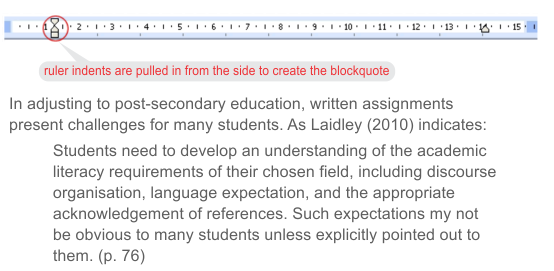Inserting references
A reference or citation can be positioned at the beginning, middle or end of a sentence. When citing multiple authors, use an '&' to separate them in the in-text citation, and an 'and' in the body of the text.
Direct quotes
Direct quotes show where another person's original thoughts, words, ideas, images etc. have been used directly in someone else's work.
Direct quotes should be used sparingly, particularly longer quotes (see below). If you use too many, you are simply reporting information that you have found. Paraphrases, on the other hand, require you to rewrite the reference in your own words showing that you have really understood the ideas or issues.
Direct quotes (short)
Follow these steps to use direct quotes in your assignments.
- Copy the exact words from the original source.
- Use quotation marks " " at the beginning and end of the copied text.
- Reference the author, year and page number information.
Example
Plagiarism issues are an area of confusion for many students beginning university, resulting in "many misunderstandings, which coincide with high levels of unintentional plagiarism, bogus referencing and collusion" (Pettigrew, 2010, p. 97).
Long direct quotes (block quotes)
For citations of 40 words or more, block quotes should be used. A block quote is indented, written on a new line and double-spaced. It does not have quotation marks around it.
Note: With block quotations, any required source details are given in parentheses.

Examples
The following examples show you how to insert a direct quote into your writing.
Reference at the beginning of a sentence
Lorenzi et al. (2004) claim "students... develop greater self-awareness in terms of time management and learning style" (p. 3) through reflective writing in a learning log.
Reference in the middle of a sentence
According to Lorenzi et al. (2004), reflective writing can develop students' metacognition, assisting "students to develop greater self-awareness in terms of time management and learning style" (p. 3) when they reflect on their studies in a learning log.
Reference at the end of a sentence
Reflective writing in a learning log can increase metacognition by assisting "students to develop greater self-awareness in terms of time management and learning style" (Lorenzi et al., 2004, p. 3).
